In The Gravest Extreme by Massad Ayoob was a phenomenal book written by police training expert Massad Ayoob. Although the book is now out of print, the tome still holds many valuable lessons.
Ayoob wrote this book as an introduction to the defensive use of firearms way back in 1980. Ayoob discusses the legal implications and practical aspects of owning and using a firearm for self defense. While the book is old, the concepts he talked about then, still hold true today. The legal requirements on the use of force have remained largely unchanged, though new concepts have entered the public’s knowledge.
Although this is not a book to teach you to be an expert with a firearm, In the Gravest Extreme was one of the best first steps anyone can take to learn to defend themselves. The book was written to a broad general audience, not specifically to police officers. However, the information that Ayoob provides is equally useful to the armed citizen and the sworn law enforcement officer.
I have often found myself in discussions with citizens in my city regarding self-defense and the use of force. I try to offer them a broad understanding of the use of force as it applies in my state, and I always suggested they read this book. Is it perfect? Of course not. But, it is an excellent place to start your studies of self-defense.
 Massad Ayoob has distinguished himself as a master trainer, marksman, and writer. I have found all of his work to be worth every penny. Without hesitation, I recommend picking up a copy of In the Gravest Extreme if you can find it.
Massad Ayoob has distinguished himself as a master trainer, marksman, and writer. I have found all of his work to be worth every penny. Without hesitation, I recommend picking up a copy of In the Gravest Extreme if you can find it.
Fortunately for the shooting public, Ayoob updated the authoritative work in 2014 and published Deadly Force: Understanding Your Right to Self Defense. The new book is greatly expanded and updates all of the information that was in the original book.
I highly recommended the original work, and I also strongly suggest that all police officers and gun owners pick up a copy of the new book and read it. It is hard to beat the original work, but the new Deadly Force book does just that. It expands the legal information provided in the first tome and broadens the suggestions for tools and training.